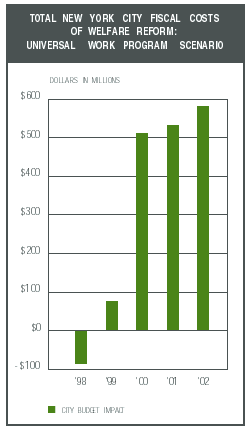|
Even if the current dramatic reduction in the city's welfare caseload continues to reduce the rolls to half of their 1995 level (to approximately 600,000 individuals), providing training, workfare jobs, and child care to workfare participants for 35 hours each week would cost the city $510 million in 2000, rising to $580 million in 2002. These costs include full-time child care at more than $6,700 per child and the pay of supervisory personnel for workfare workers. Ronnie Lowenstein, IBO Deputy Director, said, "Reducing long-term welfare dependency has been a goal of local and national officials across the range of political opinion. The IBO analysis of Mayor Giuliani's proposal was designed only to look at the fiscal implications of this major public policy initiative, and represents neither an attack on nor an endorsement of a universal work requirement." Because the city has provided virtually no data on the welfare and labor market experience of work program participants, a broader analysis of the city's work programs is not possible. Information is needed on the contributions of work program participants to city government services and on the work experiences of individuals who have left the welfare rolls or been discouraged from applying. Without that information, it is impossible to determine whether universal work requirements-as opposed to other options such as education or job training-are in the best interests of the city and its residents. Since 1995, New York City has seen its welfare caseload decrease from 1.1 million to 701,000, driven in part by the city's own efforts and federal and state mandates to reform the welfare system. Recent city policies to reduce the rolls include discouraging new applicants from applying and converting welfare centers into job centers. On July 20, 1998, Mayor Giuliani announced plans to put a universal work requirement fully in place by the end of 1999. City officials have broad financial and legal leeway to implement federal welfare reform. The city's workfare quotas have been reduced as a result of recent declines in the welfare caseload. According to IBO, the city does not have to increase the number of welfare recipients enrolled in work programs in order to meet either federal or state requirements.
Both programs arose from dramatic changes to federal and state welfare policies enacted in 1996 and 1997. These changes-including penalties for jurisdictions not complying with the new laws' requirements-set time limits on assistance, work quotas for adult recipients, restrictions on federal Supplemental Security Income (SSI) benefits for children, and limits on eligibility of legal aliens for some kinds of assistance. Family Assistance provides funds on a sliding scale (up to $577 per month for three persons) to families with minor children. Safety Net Assistance provides funds to adults without minor children, families that have reached the five-year time limit for Family Assistance, and others. As of October 1998, about 62,000 welfare recipients in New York City were participating in work or education training programs in return for their welfare grants. These included about 31,000 recipients in the Work Experience Program (WEP) who were doing clerical work in city agencies, sweeping streets, and cleaning and maintaining city parks. Studies by the Urban Institute and others have indicated that a large portion of welfare recipients nationwide, and particularly in New York City, have little education, limited work experience, and difficulty with the English language. Such people are more likely to stay on the rolls for long periods and should prove to be the most difficult to place in private sector employment. |
 ayor Giuliani's recently announced plan to require nearly all welfare recipients to leave the rolls for private employment or engage in work activities for 35 hours a week by the end of 1999 could cost the city more than $500 million annually, according to an IBO study.
ayor Giuliani's recently announced plan to require nearly all welfare recipients to leave the rolls for private employment or engage in work activities for 35 hours a week by the end of 1999 could cost the city more than $500 million annually, according to an IBO study.
 IBO's conclusions are based on an analysis of the city's current welfare program, including the federally funded Family Assistance program (formerly known as Aid to Families with Dependent Children-AFDC) and the state and locally funded Safety Net Assistance program (formerly known as Home Relief).
IBO's conclusions are based on an analysis of the city's current welfare program, including the federally funded Family Assistance program (formerly known as Aid to Families with Dependent Children-AFDC) and the state and locally funded Safety Net Assistance program (formerly known as Home Relief).